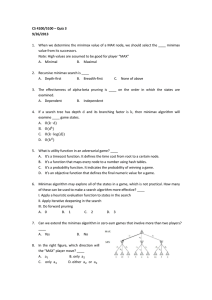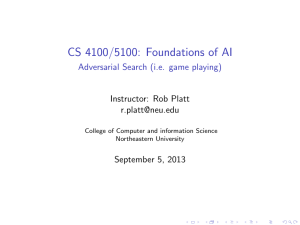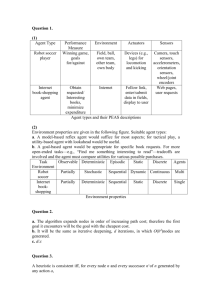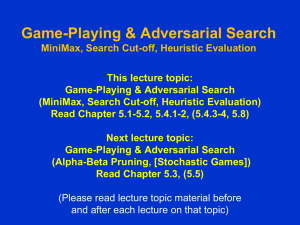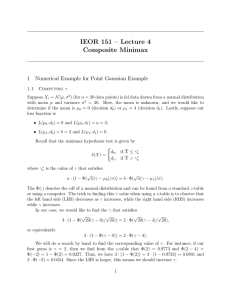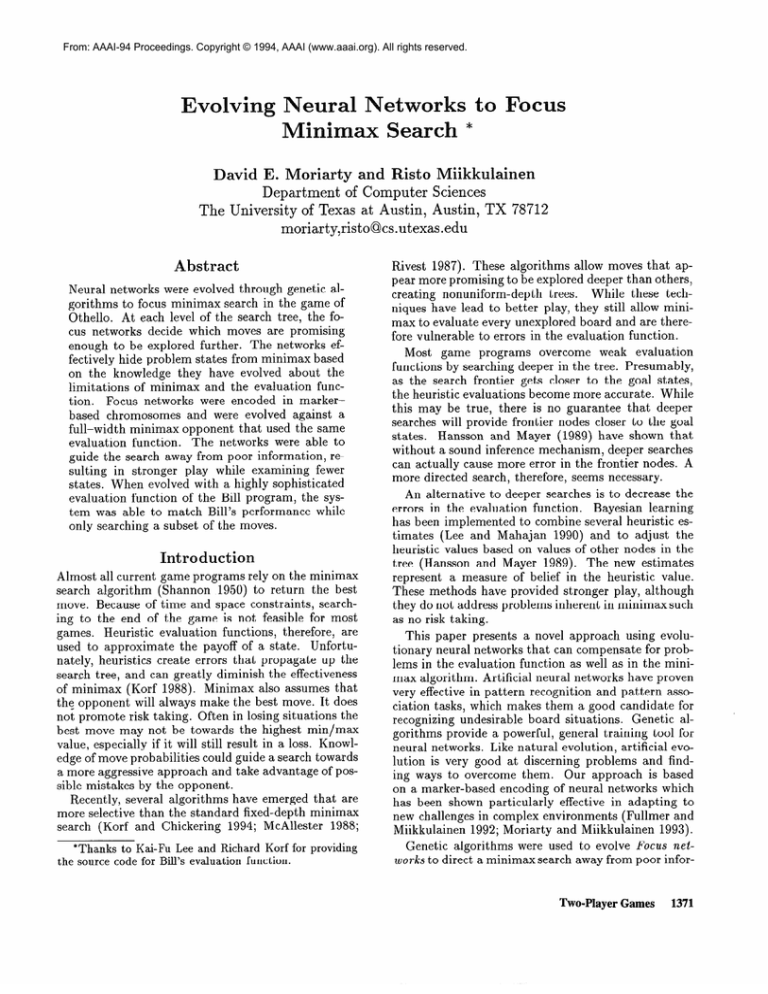
From: AAAI-94 Proceedings. Copyright © 1994, AAAI (www.aaai.org). All rights reserved.
Evolving
Neural Networks to
imax Search *
cus
David
E. Moriarty and Risto Miikkulainen
Department of Computer Sciences
The University of Texas at Austin, Austin, TX 78712
moriarty,risto@cs.utexas.edu
Abstract
Neural networks were evolved through genetic algorithms to focus minimax search in the game of
Othello.
At each level of the search tree, the focus networks decide which moves are promising
enough to be explored further.
The networks effectively hide problem states from minimax based
on the knowledge they have evolved about the
limitations
of minimax and the evaluation function.
Focus networks were encoded in markerbased chromosomes
and were evolved against a
full-width minimax opponent that used the same
evaluation function.
The networks were able to
guide the search away from poor information,
resulting in stronger
play while examining
fewer
states. When evolved with a highly sophisticated
evaluation function of the Bill program, the system was able to match Bill’s performance
while
only searching a subset of the moves.
Introduction
Almost all current game programs rely on the minimax
search algorithm
(Shannon
1950) to return the best
move. Because of time and space constraints,
searching to the end of the game is not feasible for most
games.
Heuristic evaluation functions,
therefore,
are
used to approximate
the payoff of a state.
Unfortunately, heuristics create errors that propagate up the
search tree, and can greatly diminish the effectiveness
of minimax (Korf 1988). Minimax also assumes that
the opponent will always make the best move. It does
not promote risk taking. Often in losing situations the
best move may not be towards the highest min/max
value, especially if it will still result in a loss. Knowledge of move probabilities
could guide a search towards
a more aggressive approach and take advantage of possible mistakes by the opponent.
Recently, several algorithms have emerged that are
more selective than the standard fixed-depth minimax
search (Korf and Chickering
1994; McAllester
1988;
*Thanks to Ka.i-Fu Lee and Richard Korf for providing
the source code for Bill’s evaluation function.
allow moves that apRivest 1987). Th ese algorithms
pear more promising to be explored deeper than others,
While these techcreating nonuniform-depth
trees.
niques have lead to better play, they still allow minimax to evaluate every unexplored board and are therefore vulnerable to errors in the evaluation function.
Most game programs
overcome
weak evaluation
functions by searching deeper in the tree. Presumably,
as the search frontier gets closer to the goal states,
the heuristic evaluations become more accurate.
While
this may be true, there is no guarantee
that deeper
searches will provide frontier nodes closer to the goal
states.
Hansson and Mayer (1989) have shown that
without a sound inference mechanism, deeper searches
can actually cause more error in the frontier nodes. A
more directed search, therefore, seems necessary.
An alternative to deeper searches is to decrease the
errors in the evaluation function.
Bayesian
learning
has been implemented to combine several heuristic estimates (Lee and Mahajan 1990) and to adjust the
heuristic values based on values of other nodes in the
tree (Hansson and Mayer 1989).
The new estimates
represent a measure of belief in the heuristic value.
These methods have provided stronger play, although
they do not address problems inherent in minimaxsuch
as no risk taking.
This paper presents a novel approach using evolutionary neural networks that can compensate for problems in the evaluation function as well as in the minimax algorithm.
Artificial neural networks have proven
very effective in pattern recognition and pattern association tasks, which makes them a good candidate for
recognizing undesirable board situations.
Genetic algorithms provide a powerful, general training tool for
neural networks. Like natural evolution, artificial evolution is very good at discerning problems and finding ways to overcome them.
Our approach is based
on a marker-based
encoding of neural networks which
has been shown particularly
effective in adapting to
new challenges in complex environments
(Fullmer and
Miikkulainen
1992; Moriarty and Miikkulainen
1993).
Genetic algorithms were used to evolve Focus networks to direct a minimax search away from poor infor-
Two-Player Games
1371
Estimated payoffs
Depth bound
Figure 1: A full-width minimax search to level 2. All nodes in the shaded area are evaluated. The actual payoff values of
the leaf states are listed below the depth bound. Their heuristic estimates are shown inside the leaf nodes. Min (circles)
selects the lowest payoff and max (squares) the highest of min’s choices. As a result, move 21is selected for the root.
Estimated payoffs
Depth bound
Actual payoffs
Figure 2: A focused minimax search. Only the states in the focus window (the shaded region) are evaluated.
move e appears to be max’s best choice.
mation. At each state in the search, the focus network
determines which moves look promising enough to be
The focus network is able to confurther explored.
trol which moves the minimax search can see, and can
evolve to overcome limitations
of the evaluation function and minimax by focusing the search away from
problem states.
A population
of focus networks was evolved in the
game of Othello. The results show that the focus networks are capable of stronger play than full-width minimax with the same evaluation function, while examining fewer positions.
Also, when evolved with the highly
sophisticated
evaluation function of the Bill program
(Lee and Mahajan 1990), the focus networks were able
to maintain Bill’s level of play while searching through
fewer states.
The next section describes the basic idea and implementation
of the focus networks.
Section 3 describes
marker-based
encoding and the specifics of the evolution simulations.
The main experimental
results are
presented in section 4, and discussed in section 5.
Focus Networks
Selecting
Moves
for Minimax
Focus networks decide which moves in a given board
situation are to be explored.
At each level, the network sees the updated board and evaluates each move.
Only those moves that are better than a threshold
value will be further explored.
This subset of moves
can be seen as a window to the search tree returned
by the focus network.
The .search continues until a
fixed depth bound is reached. A static evaluation func1372
Search
As a result,
tion is applied to the leaf states, and the values are
propagated
up the tree using the standard minimax
method.
The a-/3 pruning algorithm
(Edwards
and
Hart 1963; Knuth and Moore 1975) is used as in a
full-width search to prune irrelevant states.
To illustrate
how such control of minimax
might
be beneficial,
consider the following situation.
Two
moves, A and B, are considered in the current board
configuration.
Although move A returns, through minimax search, a higher evaluation value than move B,
both moves appear to lead to losing situations.
Move
B, however, can result in a win if the opponent makes
a mistake. By assuming that the opponent will always
make the best move, minimax would choose A over
B resulting in a sure loss. Focus networks, however,
could learn that a win can sometimes be achieved by
selecting move B, and they would thus not include A
in their search window.
More generally, restricting
the number of moves explored has two advantages:
(1) the branching factor
is reduced which greatly speeds up the search.
As a
result, searches can proceed deeper on more promising paths.
(2) The focus networks are forced to decide which moves the minimax search should evaluate,
and in order to play well, they must develop an understanding of the minimax algorithm.
It is possible that
they will also discover limitations of minimax and the
evaluation function, and learn to compensate
by not
allowing minimax to see certain moves.
Figures 1 and 2 illustrate the focused search process.
The current player has a choice of 5 moves (a through
e). Figure 1 shows a basic minimax search with a depth
bound of 2. The leaf states are evaluated according to
-
Network’s
lllO”SS
-
opponent’s
moves
Figure 3: The architecture
of the focus networks for Othello. Two inputs are used to encode each position on the board.
The encoding of the first four spaces (al, bl, cl, dl) f or the given board with the network playing black are shown in the
input layer. Both input nodes 1 and 2 are off since al is empty. Node 3 is on (i.e. dark) since bl has the network’s piece
in it, and nodes 6 and 8 are on since the opponent
has pieces in cl and dl (both nodes for the same position are never
The corners (such as al and h8) have
on simultaneously).
The activation
of the output layer is shown by the shading.
for the
high activations
since corners are almost always good moves. Only the input and output encoding was prespecified
network.
The input and output connectivity
and the number and connectivity
of the hidden nodes were all evolved using
genetic algorithms.
a static evaluation function.
The actual payoff value
of each leaf is shown below the depth bound.
The
difference between these values is the error or misinformation generated by the evaluation function.
The
best move is e, as it will generate a payoff of at least
11. Because of the misinformation,
however, full-width
minimax would choose move b. Figure 2 shows the
same search tree but with the addition of a focus window. Only the nodes in the window are evaluated. By
focusing the search away from the poor information,
the best move (e) would be selected. The question is,
how can we reliably form such a search window?
The evolutionary
approach is attractive because no
previous knowledge of minimax or the evaluation function is needed. The usual neural network learning algorithms such as backpropagation
(Rumelhart
et al.
1986) would require exact target values to be specified
for each training example.
Such information
is very
difficult to establish in the search focus task. In the
neuro-evolution
approach, however, evolutionary pressures will guide the networks toward providing good
windows for the search. Networks will discover misinformation by associating certain board situations with
winning and losing. Networks that prune out problem
states will win more games, allowing them to survive
and propagate their genes to future networks.
Implementation
Othello
ure 3).
in Othello
is a board game played on an 8 x 8 grid (figEach piece has one white and one black side.
Players (“white” and “black”) take turns placing pieces
on the board with their own color facing up until
there are no further moves. For a move to be legal,
it must cause one or more of the opponent’s
pieces
to be surrounded
by the new piece and another of
pieces are subsethe player’s pieces. All surrounded
quently flipped to become the player’s pieces.
Several world championship-level
Othello programs have
been created using full-width minimax search (Lee and
Mahajan
1990; Rosenbloom
1982).
Like most advanced game programs, they achieve high performance
through examining millions of positions per move.
In our implementation
of focus networks, two input
units were used to represent the type of piece in each
directly
board space. Each output unit corresponded
to a space on the board. The activation of an output
unit determined how strongly the network suggested
moving to that position.
Separate output units were
used for the two players.
Thus, the ranking for the
network’s moves may differ from the ranking of the
opponent’s moves. This distinction
is beneficial since
an aggressive player should not assume his opponent is
equally aggressive and should take a more conservative
approach when predicting his opponent’s moves. Similarly, a defensive player should not presume defensive
play from his opponents.
The separation of player and
opponent’s output units allows offensive and defensive
strategies to develop.
The number of hidden units and connections
between them were determined through evolution.
Each
Two-Player Games
1373
< start
><
< start >
< label >
<value>
< key; >
< label, >
< ‘wi >
< end >
label ><
value
><
key0 ><
label0 ><
wg > . . < key,
><
label,
><
4:
The definition
of a hidden node in marker-based
hidden unit used a linear threshold of 0 to determine
it’s output (either 0 or 1). Usually the networks contained about 120 hidden nodes and 600 connections
with a large amount of recurrency.
For each state to
be explored in a search tree an activation was propagated through the network.
The legal moves with
activation greater than or equal to 0 were included in
the search window.
-13
E
encoding.
S
21
Each focus network’s genetic representation
was based
on a marker-based
encoding (Fullmer and Miikkulainen 1992) of the architecture
and weights. The encoding is inspired by markers in DNA that separate protein definitions.
Artificial markers in the chromosome
are used to separate neural network node definitions.
Alleles serve as start markers if their absolute value
MOD 25 equals 1 and end markers if their absolute
value MOD 25 equals 2. Any integer between a start
marker and an end marker is always part of the genetic code.
The interpretation
of non-marker
alleles
depends on their location with respect to a start or an
end marker. Figure 4 summarizes the structure of the
hidden node definition in marker-based
encoding.
Each chromosome
consisted of 5000 8-bit integers
ranging from -128 to 127.
Two 8-bit integers were
used for the connection
definitions.
The lcey integer
specifies whether the connection
is to be made with
the input/output
layers or with another hidden unit.
If the key is positive, the second integer, label, specifies
a connection from the input layer (if the label is 2 0)
or to the output layer (if the label is < 0). If the key is
negative, the label specifies an input connection from
another hidden unit. Figure 5 shows an example gene
and the network information
it encodes.
The chromosome is treated as a continuous circular
entity. A node may begin on one end of the chromosome and end on the other. The final node definition is
terminated,
however, if the first start marker is encountered in the node definition.
The hidden nodes were
evaluated in the order specified in the chromosome.
A population
of 50 networks
was evolved using
standard genetic algorithms
(Goldberg
1988; Holland
1975).
A two point crossover (figure 6) was used to
produce two offspring per mating. Only the top 15 net-
1
82
3
-5
-21
14
31
80 -51
Hidden node 21
Initial Value = 1
Evolution
Search
end >
Start marker.
Label of the node.
Initial value of the node.
Key that specifies whether connection is from an
input unit/to an output unit or from another hidden unit.
- Label of the unit where connection is to be made.
- Weight of connection.
- End marker.
Figure
1374
wR ><
-
Figure 5: An example node definition in a marker-based
gene. The first connection has key = 82, label = 3, w = -5.
The key and label are both positive so the connection
is to
be made from input unit 3.
.
.
..-I..
Parent
Crossover
Offspring
Offspring
-I..................
2
.............
....,.,.,,,,.........,.,
Figure 6: Two point crossover. Each offspring receives the
front and rear part of one parent’s chromosome
and the
middle of the other parent’s chromosome.
works were allowed to mate with each other, creating
30 new offspring per generation.
The new offspring replaced the least fit networks in the population.
Traits
that previously led to high fitness levels were passed
to future generations,
whereas traits that led to poor
performance
were selected against.
Mutation,
at the
rate of 0.4%, was implemented
at the integer level by
adding a random value to an integer allele. The top 3
networks were not mutated.
To determine a network’s fitness, it was inserted into
an CL+/?
search program and played against a full-width,
fixed-depth
minimax-cu-p
search.
Both players were
allowed to search through the second level. To optimize
a-P pruning, node ordering was implemented
based on
the values of the evaluation function (Pearl 1984).
Both players always used the same evaluation func-
tion. One population was evolved based on the positional strategy of Iago (Rosenbloom
1982), one of the
first championship-level
Othello programs.
Such an
evaluation function is relatively weak as it only considers the merits of single spaces without taking mobility
into account’.
The goal was to see how well the focus
networks could evolve to make use of weak heuristic
information,
and also to provide enough errors so that
the effect of focus networks would be easily seen.
A separate population was evolved using the evaluation function from the Bill program (Lee and Mahajan
1990).
Bill’s evaluation has been optimized through
Bayesian learning and is believed to be one of the best
in the world. The goal was to see if the focus networks
could achieve any improvement
over such an already
strong heuristic.
To create different games, an initial state was selected randomly among the 244 possible board positions after four moves. To prevent networks from expecting certain moves, the opponents moved randomly
10% of the time. The random moves also make risk
taking a viable option in a losing situation since the opponent will not always make the best move. If the opponent’s evaluation function returned the same value
for two or more moves, a random selection was made
between the equal-valued moves, further discouraging
expectations.
The number of wins over ten games determined each network’s fitness.
0
100
Focused
0
Full-Width
r
Search Level of Opponent
Figure 7: The winning percentage of two level search with
and without a focus
width opponent.
n
network
against
Focused
0
a variable-level
Full-Width
100
SO
z$
6.
5
59
5
Q
aR
Results
20
The networks were evolved for 1000 generations, which
took about four days on a Sun Sparcstation
1. After evolution, the best focus network was again played
against the full-width
search program, but this time
the program made no random moves. The performance
was measured by the percentage of games won over all
244 opening games.
In the first test (figure 7), the focused search level
was fixed at 2, and the full-width opponent’s was varied. As a control, a 2-level, full-width minimax search
was also played against the full-width opponent. Note
that the focused (shaded bars) and full-width
(white
bars) searches are not playing against each other, but
against another full-width opponent. The results show
that a focused search to level 2 appears to be as strong
as a full-width search to level 4.
In the second test (figure S), the focused search level
was increased
with the full-width opponent’s.
The
control full-width
search (white bars) performs consistently at 50% because it is simply playing itself at
each level. The results show that the focused search
consistently
outplays the full-width search even as the
search level increases far beyond its training. The performance is strongest at level 2, where the focused network was actually trained, and is otherwise approximately constant
at 65%.
This result is important
‘Iago
also included
a complex
mobility
strategy.
full-
B
40 il
0
1
2
3
4
5
50
il
6
Search Level of Both Players
Figure 8: The winning percentage of a variable-level search
with and without a focus
full-width opponent.
network
against
a variable-level
because it suggests that the focus network could be
trained at any level, and would generalize well to other
search depths.
It is also important to note that the focused searches
were winning while looking at only a subset of the
states that the full-width searches are examining.
Figure 9 shows the average number of board positions examined per game for each search bound. Of all available legal moves, only 79% were included in the focus
window. The full-width search must be receiving poor
information
from minimax,
causing it to choose bad
moves. Since the focused search is using the same evaluation function and is searching to the same depth, it
appears that the focus network is shielding the root
from this misinformation.
To better understand
how the stronger
play was
achieved, the moves included in the focus window were
further analyzed. 100 test games were played against a
full-width search using the same evaluation function.
Two-Player Games
1375
18912
226
Focus
Full
121724
16684
34403
4042
662
842
Figure 9: The average number
game for each depth bound.
--A
-
Network
63304 5
230487 6
75696
330453
of states
- 0 -
per
Opponent
60 '
1
examined
I
2
3
4
5
6
Minimax Search Level
Figure
10: The percentage
as its choice
that
the focus
of moves returned
network considers.
by minimax
At each board position the moves in the focus window
were compared with the move a full-width
minimax
search would return at the same position.
Figure 10
shows the percentage
of full-width
minimax’s moves
that were included in the focus network’s window. The
graph thus reflects how often the focus network agrees
with full-width
minimax.
The results show that the
focus network is effectively
looking far ahead.
The
moves in the network’s window are similar to moves
that a deep-searching,
full-width
minimax would return (black triangles in figure 10).
However, since
the network has only been evolved against a shallowsearching opponent,
its predictions
of the opponent’s
moves become less accurate as the opponent searches
deeper (white circles in figure 10). The focus network’s
moves are strong because they are not tied to the moves
that a full-width
minimax search would choose.
Instead, they reflect moves that have led to wins. It is
this strong offense that allows the networks to scale
with the search level. It is conceivable that eventually
the network’s diminishing defense will leave it vulnerable to a powerful opponent, however that was never
observed in our experiments.
In the second population,
evolved using the evaluation function
from Bill, the best focus networks
achieved a winning percentage
of 5 1% over the fullwidth searches to the same level. Apparently,
since
Bill’s evaluation function has very few errors, the focus
networks were not able to improve the play very much.
However, it is significant
that the focused searches
achieved this performance while examining only 84% of
the moves that full-width Bill evaluated. It seems the
focus networks were able to discover and prune unnecessary nodes even with a Bayes-optimized
heuristic. In
1376
Search
a game playing setting where time constraints must be
taken into account, such an improved efficiency translates directly to better performance.
iscussion
and Future Work
The results show that better play can be achieved
through more selective search. Much like humans, focus networks selectively dismiss moves that have previously led to adverse situations.
Whereas full-width
minimax is very sensitive to inconsistencies
in the evaluation function, focused searches can actually discover
and discard unreliable information.
The approach will
be most useful in improving performance
in domains
where it is difficult to come up with good evaluation functions.
The evolution system can take a weak
heuristic and discover how to best use the information it provides. In this sense, the approach is similar
to other recent improvements
in game playing such as
Bayesian optimization
of evaluation functions
(Hansson and Mayer 1990; Lee and Mahajan
1990). A comparison of these techniques and a study of how they
perhaps could be combined would be most interesting.
In an earlier implementation
of focus networks,
a fixed-size focus window that always included the
three best moves was used (Moriarty
and Miikkulainen 1994). This strategy achieved performance
comparable to the threshold-based
window with an even
more dramatic reduction in the number of states evaluated.
However, the fixed window system was not
able to generalize well to better opponents such as Bill.
When evolved with Bill’s evaluation function, the fixed
window pruned too many nodes and performed very
poorly. On the other hand, the threshold-based
window allows the system to adjust the extent of pruning
according to how much reliable information
there is in
the tree.
It seems to make little difference how deep the system is allowed to search during training
(figure 8).
The focus networks should therefore perform well in
real game-playing
situations
where the search depth
may vary significantly depending on the available time.
However, the training opponent’s
search depth (and
evaluation function)
may have a significant
effect on
performance.
It might be possible to evolve better play
by improving the opponent gradually during training.
If the opponent gets stronger as the networks evolve,
the networks would have to compensate
by improving their defensive strategy, and superior overall play
should result.
In our implementation,
focus networks searched only
through uniform-depth
trees.
Focus networks could
also be implemented with algorithms such as best-first
minimax (Korf and Chickering 1994), where the tree is
grown in non-uniform depths allowing more promising
moves to be searched deeper.
Whereas the standard
best-first
minimax considers all unexplored board positions in the decision
of where to explore
next,
a selective window of the most important
positions could
be maintained to focus the search.
Another
application
of neuro-evolution
to game
playing is to evolve networks to serve as the evaluation function.
Interestingly,
the results have been discouraging so far. Whereas the focus networks’ output
values only need to indicate above or below a threshold, the evaluation networks’ output units must reflect
an absolute value comparable
to other board evaluations. It has proven very difficult for the networks to
discover such global values.
While focus networks may be well suited for Othello,
their implementation
in more complex games like chess
is not as straightforward.
In our implementation,
the
output layer represented the entire move space. This
is feasible in Othello, since there are only 60 possible moves. It is unrealistic to try to represent the entire move space of a game such as chess in a single
output layer. A possible solution is to use two focus
networks in the decision process.
The first network’s
output layer would represent each piece and would decide which pieces to consider.
The second network’s
output layer would represent each space on the board
(as in the Othello networks).
Given the current board
and the piece to be moved, the second network could
decide which moves of a given piece to consider. Such
an extension constitutes
a most interesting direction of
future research.
Artificial evolution of neural networks is a promising
paradigm for developing better search strategies.
It is
possible to identify unreliable information in the search
tree and find ways to avoid it. Focus networks can
overcome not only errors in the evaluation function but
flaws inherent in minimax itself. Focused searches are
cognitively
more appealing since they produce more
human-like search rather than systematic
exhaustive
search. In Othello, a focused search consistently
outplayed full-width minimax while examining a subset of
the moves. Even with a highly sophisticated
evaluation
function, the focus networks were able to create a more
efficient search by pruning irrelevant nodes. Applications to more complex domains are more challenging,
but not infeasible.
References
and Hart, T. (1963).
The
Technical Report 30, MIT.
alpha-beta
Fullmer, B., and Miikkulainen,
R. (1992).
Evolving
finite state behavior using marker-based
genetic
encoding of neural networks.
In Proceedings
of
the First European Conference
on Artificial Life.
Cambridge,
MA: MIT Press.
Goldberg, D. E. (1988). G enetic Algorithms
Optimization
and Machine
Learning.
MA: Addison-Wesley.
Hansson,
O., and Mayer, A. (1990).
Probabilistic
heuristic estimates.
Annals of Mathematics
and
Artificial Intelligence,
2:209-220.
Holland, J. H. (1975). Adaptation in Natural and Artificial Systems: An Introductory Analysis with Applications to Biology, Control and Artificial Intelligence. Ann Arbor, MI: University of Michigan
Press.
Knuth, D. E., and Moore, R. W. (1975). An analysis of
alpha-beta pruning. Artificial Intelligence,
6:293326.
Korf, R. E. (1988). S earth: A survey of recent results.
In Shrobe, H. E., editor, Exploring Artificial Intelligence. San Mateo, California:
Morgan Kaufmann.
Korf,
R. E., and Chickering,
D. M. (1994).
Best-first
minimax search: Othello results.
In Proceedings
of the Twelth National Conference
on Artificial
Intelligence.
Lee, K.-F., and Mahajan,
S. (1990). The development
of a world class Othello program. Artificial Intelligence, 43:21-36.
McAllester, D. A. (1988). Conspiracy numbers for minmax search. Artificial Intelligence,
35:287-310.
Conclusion
Edwards,
D.,
heuristic.
Hansson, O., and Mayer, A. (1989).
Heuristic search
as evidential reasoning. In Proceedings of the Fifth
Workshop on Uncertainty in AI.
in Search,
Reading,
Moriarty, D. E., and Miikkulainen,
R. (1993).
Evolving complex Othello strategies using marker-based
genetic encoding of neural networks. Technical Report AI93-206, Department of Computer Sciences,
The University of Texas at Austin.
Moriarty, D. E., and Miikkulainen,
R. (1994). Improving game tree search with evolutionary neural networks. In Proceedings of the First IEEE Conference on Evolutionary
Computation.
Pearl, J. (1984). Heuristics:
Intelligent Search Strategies for Computer Problem Solving. Reading, MA:
Addison- Wesley.
Rivest, R. L. (1987).
approximation.
Rosenbloom,
Othello
320.
G ame tree searching by min/max
Artificial Intelligence,
34:77-96.
P. (1982).
A world championship-level
Artificial Intelligence,
19:279program.
Rumelhart,
D. E., Hinton, G. E., and Williams, R. J.
(1986). Learning internal representations
by error
propagation.
In Rumelhart,
D. E., and McClelland, J. L., editors, Parallel Distributed Processing: Explorations
in the Microstructure
of Cognition,
Volume 1: Foundations,
318-362.
Cambridge, MA: MIT Press.
Shannon, C. E. (1950).
Programming
a computer for
playing chess. Philisophical Magazine, 411256-275.
Two-Piayer Games
1377

